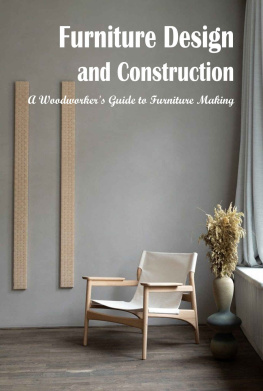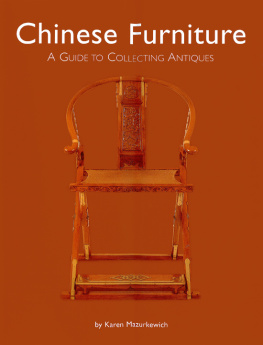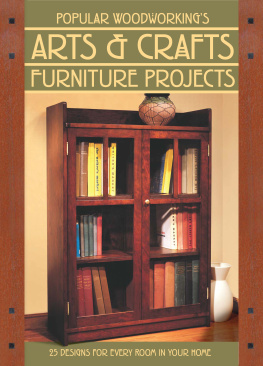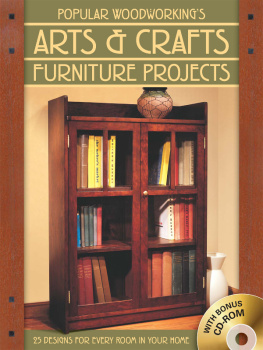

Published by The History Press
Charleston, SC 29403
www.historypress.net
Copyright 2014 by Clarence Carlson
All rights reserved
First published 2014
e-book edition 2014
ISBN 978.1.62584.779.9
Library of Congress Cataloging-in-Publication Data
Carlson, Clarence, author.
The Jamestown furniture industry : history in wood, 1816-1920 / Clarence Carlson.
pages cm
Summary: While all but gone today, Jamestowns furniture industry was once thesecond-largest producer of furniture in the United States. Manufacturing boomed from 1816, when William Breed and Royal Keyes opened their shops, to the 1920s, when Jamestown was still one of the top wood furniture producers in the country. In the nineteenth century, the thriving railroad industry allowed Jamestowns quality creations to be distributed nationwide. After the Civil War, an influx of Swedish immigrants brought their craftsmanship and skills to Jamestown, forming Morgan Manufacturing, Empire Furniture Company and many others. Then, their pieces were valued for quality and durability; today, theyre coveted by collectors as beautiful antiques. Local expert Clarence Carlson uncovers the fascinating story of Jamestown furniture--Provided by publisher.
Summary: Explore the history and development of the furniture industry in Jamestown, New York--Provided by publisher.
print edition ISBN 978-1-62619-295-9 (paperback)
1. Furniture industry and trade--New York (State)--Jamestown--History. 2. Furniture making--New York (State)--Jamestown--History. 3. Jamestown (N.Y.)--Biography. 4. Swedes--New York (State)--Jamestown--Biography. I. Title.
HD9773.U53J363 2014
338.47684100974795--dc23
2013047031
Notice: The information in this book is true and complete to the best of our knowledge. It is offered without guarantee on the part of the author or The History Press. The author and The History Press disclaim all liability in connection with the use of this book.
All rights reserved. No part of this book may be reproduced or transmitted in any form whatsoever without prior written permission from the publisher except in the case of brief quotations embodied in critical articles and reviews.
In memory of Carl A.J. Carlson, cabinetmaker and my DAD.
Contents
Preface
The ultimate goal of this book is to compile a written history of the furniture industry in Jamestown, New York, from its inception in 1816 to the 1920s. Within the pages of this book, 112 companies are detailed and another 30-plus (because of lack of information) are given a brief history. While reading about furniture factories that employed from as few as ten to as many as four hundred skilled workers, you may ask yourself, How did this all begin and what led to its downturn and near demise? I will try to answer those questions.
In researching the early reasons for the development, four well-known local authors were referenced. They are considered by Jamestown historians to be authorities on the early history. In part, they wrote about furniture manufacturing being the first industry to grow out of the local lumber mills.
Elial Todd Foote, a physician and early settler, came to Jamestown in the spring of 1815 at the age of nineteen. One of his greatest accomplishments was the compiling of early newspaper articles, personal accounts, notes and letters from early pioneers tracing the growth of Jamestown. He compiled an accurate picture of Jamestown up to about the 1840s. These notes were well kept, and though some were damaged and lost, in many ways, they gave the reader an image of day-to-day life in a growing pioneer town.
Andrew Young used excerpts from the original notes and published a book in 1875, History of Chautauqua County, N.Y. Those original Foote documents that Andrew Young, and others to follow, used are now the property of the Prendergast Library Archives and the Chautauqua County Historical Society. Obed Edson, a Chautauqua County historian, also wrote a book in 1894, The History of Chautauqua County, using some of Footes documents. Another man who contributed much to compiling a history of the city of Jamestown was city historian Arthur W. Anderson, who published The Conquest of Chautauqua in 1932. His historical account of Chautauqua County and the development of Jamestown is an accurate depiction of historical locations of early Jamestown buildings. Anderson used excerpts from G.W. Hazeltines book The Early History of Ellicott, published in 188586, and the notes by Foote. All of these books are excellent research and reading material for the person who wants to indulge in the history of Chautauqua County and Jamestown. The Jamestown City Directories, Jamestown newspapers and other booklets available for reading and research at the Fenton History Center are good sources of reference.
Many have asked me, How did you get started on this project? I have been a local history buff for a number of years, buying any released publication on Jamestown history and keeping my eyes open at garage and household sales for any out-of-print books. It was during the long, cold winter nights of 2001 that I began to read through a couple volumes of books in my home library: The History of Chautauqua County and Its People, volumes two and three, published in 1921. These books contained references to furniture factories I had never heard of before.
My dad was a cabinetmaker from Sweden who initially worked in the mines of Pennsylvania and then relocated to Jamestown to work in the furniture shops. I recognized the names of the companies where he had worked.
But there were many other companies, and in many cases, the books would tell when they were founded, the location, establishment dates and products. I formed an outline of these companies and their founders for my own research and to pass the time. By the time I was done, fifty-three furniture companies were listed, and I knew there was more to the story that needed to be investigated.
As my research continued, it became clear that the furniture industry played a major part in the development of the city of Jamestown. Unfortunately, the history books offered bits and pieces of information about the furniture companies, but an inclusive manuscript did not exist. That was all the incentive I needed, and as they say, the rest is history.
I would like to thank the Fenton History Center and its executive director, Joni Blackman, who initially supported the writing of this book by forming a book committee. The committee members include Traci Langworthy, Kathy Barber, Karen Livsey, Sam Genco and Paul Leone. Much appreciation goes to the people who have given me support (and a push when needed): Ken Prince, Norm Carlson, Kathy Foster and Dianne Carlson, just to mention a few.
Thank you to two very special friends: Pam Brown, who helped me prepare the manuscript and has been a big asset to the completion of the book, and photographer Ed Vos. Their time, support and expertise helped bring this project to fruition. My gratitude goes out to all those folks who have continued to take an interest and offer their ideas on the approach to this project.
What began as a mild interest in a bit of Jamestowns history became a work of love and respect in honor of so many of those furniture makers. They were true artisans.
Introduction
Jamestown is a city in southwestern Chautauqua County, New York. It is situated between Lake Erie to the northwest and the Allegheny National Forest to the south. It is the largest population center in the county. The city was once known as the second largest Furniture Maker in the United States, where visitors from all over the world attended furniture expositions at the Furniture Mart Building that still stands today. Wood furniture manufacturing was a significant component of early industrial development in Jamestown. It was a direct outgrowth of the early nineteenth-century lumber industry that brought the settlers to Chautauqua County. In part, it was the reason Jamestown, this hamlet of a dozen or so families in 1815, prospered. Obed Edson wrote of Footes account describing the hamlet of Jamestown in 1816 as little more than a ragged hole in a gloomy forest wilderness. Only about sixty acres had been cleared, and swamps, burned logs, stumps, mire holes and unpainted cabins perched on wooden blocks were the chief features of the clearing, while surrounding this on every side a forest of majestic pines towered heavenward.
Next page










